All Dryers Are Customized
Engineers available to offer overseas service
All Year Round After Sale Hotline
Free Remote Technical Support and Train
Warranty: 1 Year
Certification: ISO9001
Application: Leather Sludge, Tannery Sludge, Fur sludge, Metal sludge, Clay, Sticky sludge, Chemical sludge
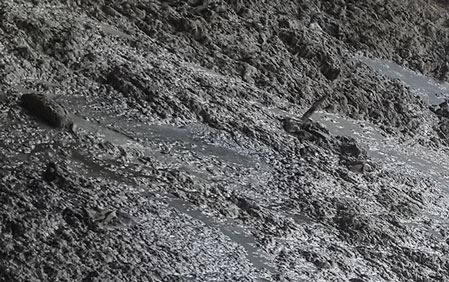
Before Drying
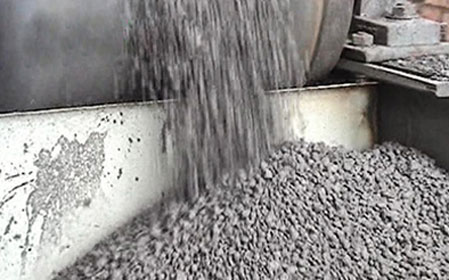
After Drying
Volumes of tannery sludge are increasing all over the world. The sludge from leather processing consists of organic and inorganic substances. The chemical composition of inorganic substances commonly presented in tannery sludge includes the following elements and their chemical compounds: nitrogen, ammonia, sulphides, calcium compounds, chromium salts (especially sulphates) as well as high chromium content. The most toxic chemical element formed during leather tanning is chromium which is oxidized from chromium. Chromium is carcinogenic, mutagenic and can cause allergy. According to the current legislation, the permissible level of chromium in tannery sludge is 3 mg/kg.
Harmful sludge normally cannot be disposed to landfills due to the high content of chromium that drains away from the materials and enters the soil and groundwater. Therefore, efforts is being carried out to prepare this waste for proper use in the production of building materials. The Dry sludge can also be used to make building materials.
Sludge from drying period having a moisture of about 50% was collected. Clay from nearby kiln was wetted and kept for 30 minutes setting. Both sludge and clay were mixed manually. It was observed that the mixing produced a very good homogenous mass. No water was added. The sludge and clay were mixed in equal proportion. This endeavor has a dual purpose: First, it makes use of an environmental unfriendly waste and second, it decreases the amount of clay used in the process. A third advantage may pop out from amelioration in the bricks properties or a decrease in the energy required for firing.
Tannery/leather/fur sludge is a solid waste (tannery solid waste) that needs to be carefully managed, because it contains a lot of sulfur, chromium and other chemical substances, classified as hazardous waste. It should be particularly careful in sludge treatment equipment selection.
This ZJN drying machine is rotary drum dryer, sludge directly and fully contact with hot air, and dry immediately. The waste water and air discharged immediately, which can avoid the re-absorption. The dry sludge moisture content can be below 10%. Working continuously for 24 hours per day. Few quick-wear part, only one or two supervisor is needed, low operating cost!
The dry sludge can be mixed with coal as fuel. After burning, all the harmful organic matter and pathogens in the sludge will be removed. It can protect the land and water resources from pollution. In addition ZJN drying equipment is equipped with dust removal equipment, can handle the dry process of toxic and harmful substances.
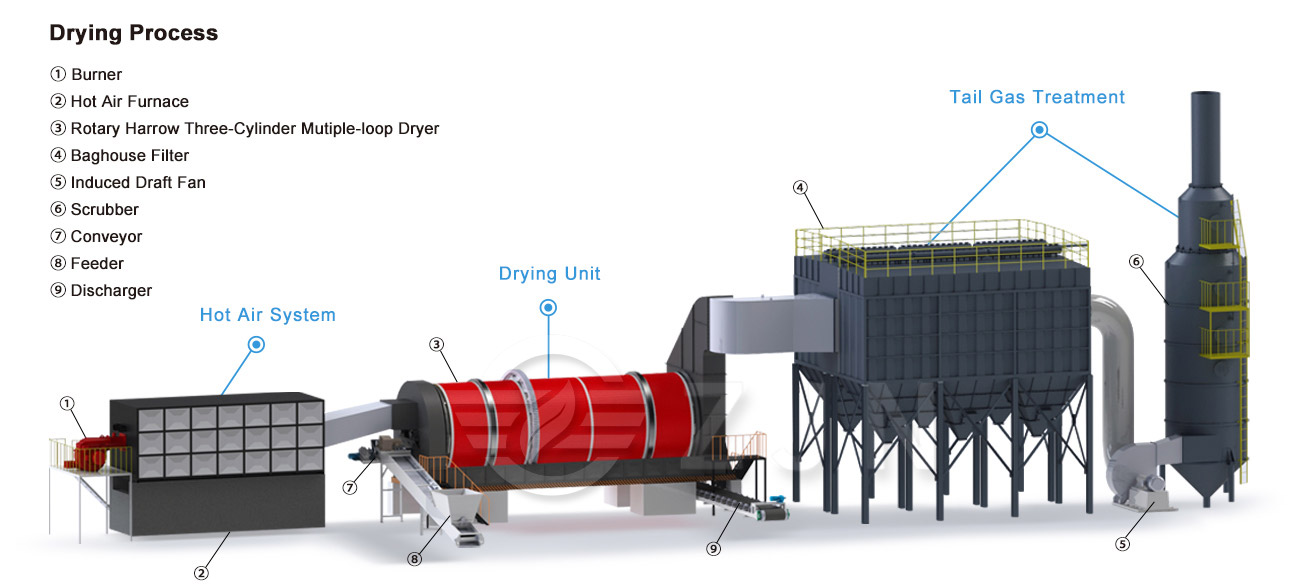
Sludge dryer production line generally includes the following system devices: heating system, conveying device, feeding system, discharging device, induced draft system, dust collector equipment, sludge dryer, instrument control system, etc.
ZJN sludge dryer is made of wear-resistant and high temperature resistant stainless steel, which has better quality and longer service life than ordinary steel. The equipment can use natural gas, steam, biomass particles, fuel oil, coal, boiler exhaust and other heat sources for heating. From the appearance point of view, the main body of the sludge dryer adopts a multi return structure, which is shorter than the traditional single drum dryer, occupies a smaller area, and is convenient for installation and disassembly. It effectively solves the problems of easy adhesion and wall sticking in the drying process of high humidity and high viscosity sludge. The new internal structure of the cylinder greatly expands the application scope of the equipment, making ZJN sludge dryer suitable for drying different types of high humidity and high viscosity sludge in many industries.
In addition, ZJN provides users with perfect customized service of sludge dryer. According to the characteristics of materials, output, drying degree, site size and other requirements, scientific and reasonable drying scheme can be designed to meet the diversified drying needs of users.
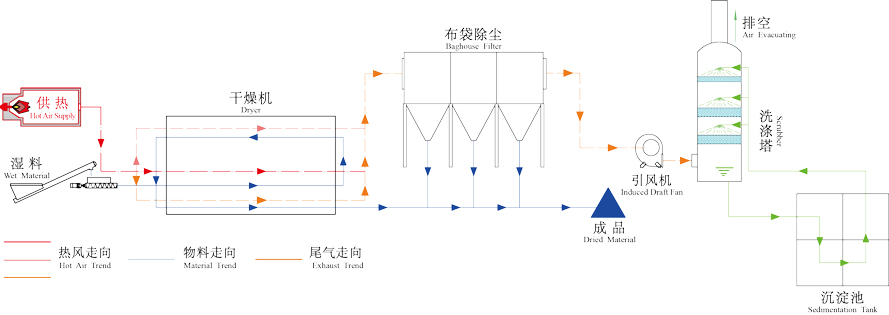
During the production process of ZJN sludge dryer, the wet sludge is transported into the drum through the feeding device. The "rotary rake crushing" dispersal device set in the drum first breaks the sludge into small particles, then, under the rotation of the combined lifting device, the material is constantly thrown up and scattered, and the uniform material curtain is lifted on the cross section of the cylinder. The area of heat exchange is greatly increased, the evaporation intensity of the equipment in unit time is greatly increased, the heat energy is effectively used and the heat loss is reduced. Therefore, ZJN sludge dryer will work efficiently and dry well.
The special exhaust mode can effectively avoid the phenomenon of moisture return at the end of the material and uneven drying. The whole drying process can be divided into three stages. While the sludge evaporates rapidly, the water vapor can be discharged from the end of each stage of drying. Compared with traditional drying equipment, ZJN sludge dryer has faster breaking speed, more scientific and reasonable arrangement of lifting device, making wet materials not easy to stick to wall and agglomerate in drying process, making equipment cleaner, environmental protection and energy saving, and greatly extending service life.

We have different hot air generating device for you. According to your Heat Source, no matter it is natural gas, bio-gas, coal, oil, bio-mass fuel or others, we match furnace, chamber, burner etc to be most suitable. What's more, the boiler flue gas can also be used as heat.

The sludge dryer is suitable for electroplating sludge, heavy metal sludge, leather sludge, chemical sludge, printing and dyeing sludge, textile sludge, pharmaceutical sludge, paper sludge, sewage plant sludge, municipal sludge, industrial hazardous waste sludge, alkali sludge, slag and other materials drying.
It is widely used in electroplating enterprises, metal processing enterprises, paper enterprises, textile printing and dyeing enterprises, pharmaceutical plants, sewage treatment plants, chemical enterprises and other industries.
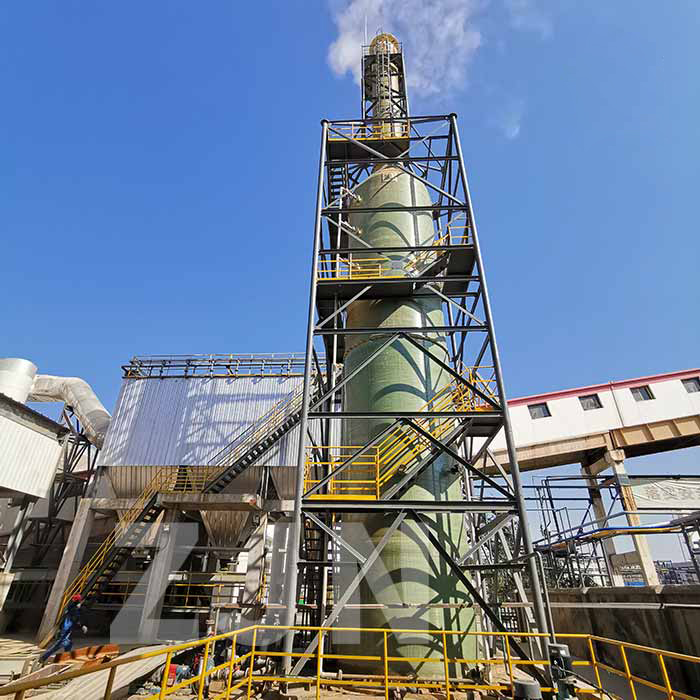
Scrubber
Scrubber systems (e.g. chemical scrubbers, gas scrubbers) are a diverse group of air pollution control devices that can be used to remove some particulates and/or gases from industrial exhaust streams.
The exhaust gases of combustion may contain substances considered harmful to the environment, and the scrubber may remove or neutralize those. A wet scrubber is used for cleaning air, fuel gas or other gases of various pollutants and dust particles. Wet scrubbing works via the contact of target compounds or particulate matter with the scrubbing solution. Solutions may simply be water (for dust) or solutions of reagents that specifically target certain compounds.

Cyclone Dust Collector
Centrifugal cyclone dust collector, the dust will be separated and recovered in the drying system, through the dry tail gas dust purification device of a cyclone dust collector, suitable for high dust concentration, large dust particles of exhaust gas dust removal operations, the dust collector has a simple structure, stable and reliable operation, long service life, and other characteristics.

Baghouse
A bag house, also known as a bag house filter, bag filter, or fabric filter is an air pollution control device and dust collector that removes particulates or gas released from commercial processes out of the air.
Most baghouses use long, cylindrical bags (or tubes) made of woven or felted fabric as a filter medium. For applications where there is relatively low dust loading and gas temperatures are 250 °F (121 °C) or less, pleated, non woven cartridges are sometimes used as filtering media instead of bags.
Bag houses are very efficient particulate collectors because of the dust cake formed on the surface of the bags. The fabric provides a surface on which dust collects through the following four mechanisms:
Inertial collection – Dust particles strike the fibers placed perpendicular to the gas-flow direction instead of changing direction with the gas stream.
Interception – Particles that do not cross the fluid streamlines come in contact with fibers because of the fiber size.
Brownian movement – Sub micrometre particles are diffused, increasing the probability of contact between the particles and collecting surfaces.
Electrostatic forces – The presence of an electrostatic charge on the particles and the filter can increase dust capture.
A combination of these mechanisms results in formation of the dust cake on the filter, which eventually increases the resistance to gas flow. The filter must be cleaned periodically.

1. Design of high humidity and high viscosity sludge
In order to achieve the purpose of non sticking and non sticking, the internal structure of sludge dryer has been upgraded and modified by ZJN. Through the combined lifting device, the material moves at high speed under centripetal force, and is gradually breaked into smaller particles, and fully contacts with hot air, increases heating energy utilization and drying speed, and avoids sludge sticking to the wall of the cylinder.
2. Energy saving and low operating cost
The special multi-loop structure makes ZJN sludge dryer occupy less land area and effectively reduce the investment in infrastructure. In addition, the equipment has good thermal insulation performance and small heat loss. Compared with the traditional single drum equipment, fuel consumption is greatly reduced and the equipment operation cost is low.
3. Clean and dry, environmental protection up to standard
The equipment has good sealing performance, no dust particles overflow during drying process, and the production environment is clean. The waste gas can be discharged after being collected and filtered by exhaust gas collecting system, cyclone and baghouse (bag dust collector), and can meet the environmental protection standards. The user can use it without worry.
4. The entire drying system is centralized control by ABB/Simens PLC, easy to operate. In the drying equipment, drying, crushing, sieving and conveying process are combined to operate. The whole process is simplified and easy to control automatically. Fully automatic, easy and stable operation.
5. High thermal efficiency, long drying time, large treatment capacity. Down-flow in the first stage cylinder, counter-flow in the second stage cylinder, down-flow in the third stage cylinder, W+S type material transfer trend. Material mixed well with hot air. What’s more, the hot air volume can be distributed into three cylinder drum in different volume according to the wet material mositure content, which we use high mositure content, high air volume and temperature; medium himidity choose moderate volume and temperature; low humidity uses small volume and low temperature, making the material can be always in the ideal drying environment.
6. Drying equipment continuously working 24 hours, continuously feeding wet material and continuously discharging finished product.
Copyright ©2022 by Jiaozuo ZJN Environmental Protection Equipment Technology Co., Ltd.